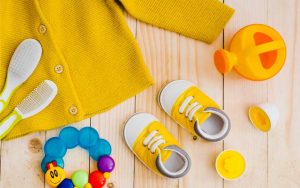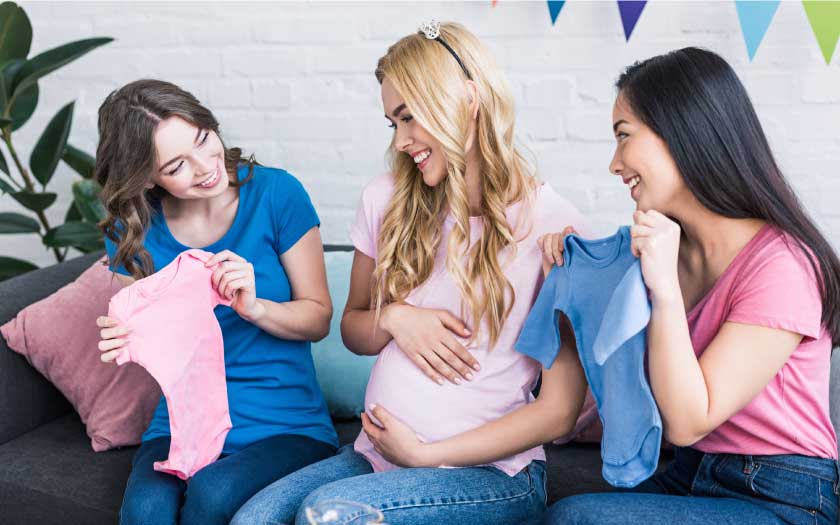As any parents-to-be can testify, buying clothes for their newborn baby has got to be one of life’s most gratifying experiences — all those colours and prints on tiny baby wear are sure to make anyone go ga-ga. Still, how will you know if you’re making the right choices? Here are some tips.

Babies are known to grow out of their outfits really quickly, so it makes little sense to purchase cupboards full of baby clothes, no matter how cute they look or how tempting the sale/offer prices are!
When stocking up on basics before your baby arrives, purchase only a few items in newborn size. Your baby will outgrow these tiny garments fast — sometimes in less than a month. It’s more practical to buy in the 3-to 6-month or 6-to-9-month sizes.
Money-saving tip
You’d be surprised at the amount of newborn clothes that come as gifts during baby showers! Assuming that you’re planning to have one, try to hold off purchasing newborn clothes till after the baby shower — you could end up saving a lot of money plus, you’ll also be avoiding wastage, for often enough, babies are known to not even have a chance to put on a good many new clothes due to their rapid growth for the first few weeks.
General sizing indications for infant clothes
- Newborn : 0–3 months
- 3 months : 3–6 months
- 6 months: 6–9 months
- 9 months: 9–12 months
Loose is better than tight
When in doubt, always go for larger sizes. Clothing that is too small or tight will be uncomfortable and when that happens, you’ll end up not using them. Where else, if the clothes happen to be a little on the large size, babies will grow into them in no time!
Fabric
Nothing beats the softness of babies’ clothing made from 100% cotton, preferably organic, but baby clothes made from any other soft, cotton-
blend material will also do fine. Labels on a new clothing item must state fiber content.
Baby clothes labels should also carry care instructions. All-cotton knits may look large when new, but they can shrink as much as 10 percent with repeated washing! Polyester/cotton blends are less expensive than a pure cotton or organic cotton and more resistant to wrinkles and shrinking.
Rash alert
If the baby seems to develop any redness in the area behind the neck, you can try cutting off the tag of the outfit.
Easy wearing
Complicated designs can be cute to look at, but they can also be a bit difficult to put on and get off from a baby. Buttons too may sometimes be difficult to manage compared to zippers, especially if you’re trying to dress a squirmy, wriggly baby! Look for designs with a stretchy neck hole, which is easy to manage when handling a newborn.
Choose diaper-friendly designs
Babies will need their diaper changed often, so it will be a good idea to ensure that the clothes you buy will be able to accommodate diaper changes easily. Sleepwear, especially, should be diaper friendly so as not to disturb your sleeping baby too much. Most baby bodysuits and sleepers have snaps at the crotch. Steer clear of overalls for infants and similarly complicated items, since they have to be pulled off completely for diaper changes. There are also bodysuits with envelope folds at the neckline which can be gently pulled down over your baby’s body and removed. It’s much less annoying to a baby than having to pull them over the head.
Safety in baby clothes — A legit concern
A baby’s clothing should ideally be simple to avoid anything being pulled off by those busy, tiny hands. Anything that can come off baby clothing can be a choking hazard, so it’s best to dress a baby in clothes without appliqués, buttons, and ribbons. Most trusted baby-clothing brands avoid these types of embellishments on their garments but many clothing bought from small baby boutiques tend to have them. If you feel like dressing your baby in one, tug at the embellishment or appliqué to ensure that it does not come off easily.
Baby sleepwear safety tips
Resist oversized sleepwear but do not squeeze your newborn into a too-snug garment either. A newborn sleep bag can be the most would be a good replacement for loose blankets in your baby’s crib, which are a suffocation hazard. Baby sleep bags don’t fit snugly and there’s plenty of kicking room. They’re typically made of flame-resistant fabric, but check the garment’s label to be sure. When using a sleeping bag, your baby has to be dressed in a sleeping garment that is suitable for the material of the sleeping bag and also the temperature of the room your baby is in.
Strangulation hazard
Drawstrings, either at the neck or waist of baby clothing can pose a strangulation hazard and catch on playground equipment or furniture. You can either remove them or make sure they are sewn securely and can’t be pulled out more than three inches at either end.
Low to mid-priced baby clothes
Due to the sheer scale of production both locally and internationally, many brands of baby clothes are quite competitively priced. (Some of these may be ‘brand-less’ too.) When going for these, ensure that the fabric is soft enough and the quality is justifiable. As for the fashion, style, and visual appeal, look out for competent workmanship. Most clothes in this category of prices are machine washable.
Upscale baby clothes
Most baby clothes from this category are from well-known international brands and are quite pricey. Some of these, though not necessarily all, are of exceptionally good quality and durability, giving some satisfactory value to the purchase. For the sake of your wallet, watch for sales on brands you might like if you just have to have some from this category. Remember though that some high-end baby clothes may even require hand laundering or dry cleaning. Tip: Air out any dry-cleaned clothes before your baby wears them.
Wash before use
Most new clothing, even a baby’s, undergo various processes that leave chemical residue on them. Wash all baby clothing before use.
Organic baby clothes
You’ll have to check the label for this: If the label says that the item is 100-percent organic, it means that the cotton in the clothes was grown without synthetic pesticides and other such chemicals. This is will be the main indication of an organic piece of baby clothing, for cotton is a crop that uses the most amount of pesticides! Hence, buying organic baby clothing will not only be better for a baby, but it’s indirectly better off for the planet too.
Keep in mind though, that an organic label certifies only the growing methods of the fiber in the item, not the way it was processed into fabric. There’s no guarantee that clothes marked “made with organic cotton” have escaped being chemically treated after that. If you want to buy truly “green” baby clothes, check whether the tag or manufacturer’s website has information on how the clothes were processed, what kind of dyes were used, etc.


